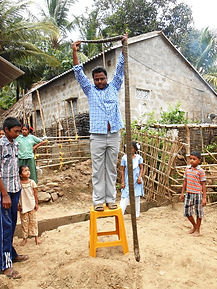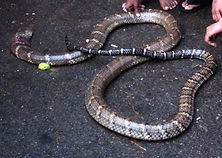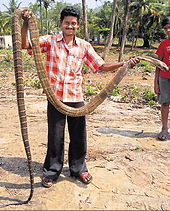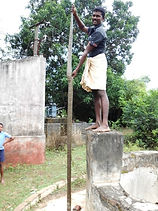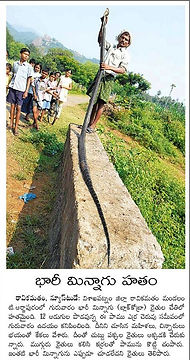
Eastern Ghats Wildlife Society
EGWS Latest Wild King Rescue Videos
EGWS is happy to present a second episode of THE FORGOTTON KINGDOM series with never seen footage of the King Cobras in the Eastern Ghats of Andhra Pradesh.
Link for Video

First King Cobra Nest Conservation Success in the Eastern Ghats
A great success and a milestone for our king cobra conservation efforts in the eastern ghats! A total of 25 little kings were released into the wild after guarding the nest for over a month with some incredible support from the local communities who have been sharing their living space with the nesting habitat of the longest venomous snake in the world! We heartily thank the local communities, Andhra Pradesh Forest Department, all our supporters and followers for being with us throughout this amazing journey! The female King Cobra is the only snake in the world that builds a nest to lay around 30 eggs. For the first time in the conservation history of the eastern ghats, we have initiated an entirely community-led king cobra nest protection program at a tribal hamlet in Northern Andhra where we have been working with local communities to conserve the nesting habitat of the king cobra. After the female abandons the nest, the eggs are prone to predation as well as human disturbances since this nest location happens to fall in close proximity to a village and people use well-beaten paths near the nest to move around by walking. A temporary fence was erected by the locals with our support and as per the suggestions of Sri Rom Whitaker of Madras Crocodile Bank Trust to protect the eggs.
EGWS Beautiful King Video
We are delighted to release our new short film documentary on king cobra conservation paradigm in human-dominated landscapes of the Eastern Ghats in Andhra with first-ever exclusive footage of king cobras in the wild! Please watch the video and share your comments.
EGWS has started a temporary field office in prime King Cobra habitat of Visakhapatnam district. Currently, we have only set up a temporary structure with locally available materials.
The main functions of the field station are:
1. To serve as our field base for all our project activities. A place where we can work, cook for ourselves, and rest.
2. To invite wildlife enthusiasts and students who are keen on experiential learning programs.
3. To organize workshops and meetings on capacity building of different stakeholders.
4. To serve as a learning space about Eastern Ghats Wildlife and King Cobras in specific for the general public.






Photo credits: Arunkumar Thaydi & Madhu Sabbavarapu


Photo Credit: Arunkumar Thaydi
Photo Credit: Arunkumar Thaydi
Photo Credit: Sabbavarapu Madhu
.jpg)
Project abstract:
Eastern Ghats Wildlife Society initiated a first ever King Cobra conservation program in the Eastern Ghats of North Andhra state in collaboration with Andhra Pradesh Forest Department to mitigate redundant killings of king cobras by local communities and foster a harmonious relationship between king cobras and humans. The organization also works with Madras Crocodile Bank Trust on snakebite mitigation in these areas.
A unique "Snake Savior Program" was initiated to build local capacity in snake rescue and snakebite management by engaging local community members and training them as "snake saviors" who, in turn, help their communities. The organization has also conducted many capacity building workshops for the frontline staff of the state forest department.
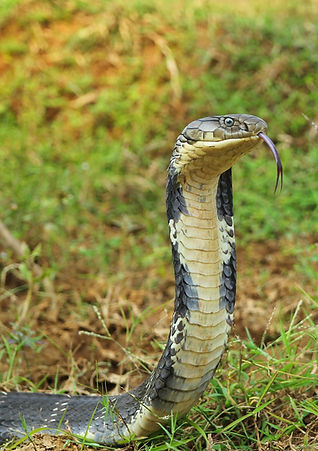_JPG.jpg)


Our field assistant recently recorded an amateur video of a King catching a Spectacled Cobra! We received the rescue call from an area where we have been working for the past few years sensitizing people about Kings. Therefore, we didn't have to remove the King and it was allowed to enjoy its meal while locals also watched in excitement. Something we all get to see usually in places like Agumbe!
We also rescued a hatchling when it accidentally strayed into a village then released the tiny King back into its kingdom. This juvenile measured approximately 12 inches in length. (most probably hatched this season)




On World Snake Day, meet the king cobra rescue team working in Andhra’s Eastern Ghats region
Nivedita Ganguly
Eastern Ghats Wildlife Society has rescued 35 king cobras in North AP under its King Cobra Conservation project in collaboration with AP State Forest Department
Murthy Kantimahanti stands still, almost lifeless, as he stares at the 13-foot king cobra ahead of him. The cobra's forked tongue flicks while Murthy takes a snake hook in one hand and catches the tail of the snake. It twitches agitatedly as the reptile coils the tail around Murthy's arm. A group of villagers stand at a distance across the green agricultural fields under the hot afternoon sun at Cheedikada village in Visakhapatnam district. Located about 60 kilometres from Visakhapatnam, Murthy has come to rescue the king.
"King cobras are shy and avoid humans whenever possible," says Murthy, the founder of Eastern Ghats Wildlife Society (EGWS). Over the past five years, EGWS managed to rescue 35 king cobras in the Eastern Ghats of North Andhra Pradesh under its King Cobra Conservation and Human-Snake Conflict mitigation project. In collaboration with the AP State Forest Department, the project has covered 40 villages for human-snake conflict mitigation programmes and capacity building initiatives in Visakhapatnam, Vizianagaram and Srikakulam districts.
Habitat destruction
The rapid destruction of their natural habitat and overwhelming rates of human-snake conflict (snake-bite incidences) have posed a big threat to the king cobra, the world’s longest venomous snake, that has been listed as ‘vulnerable’ in the IUCN Red List since 2010. "The vastness of the landscape in the Eastern Ghats and bordering villages; the lack of trained snake rescuers to cover more areas; the pandemic-induced restrictions and barriers which slowed down our conservation outreach programmes and breaking rigid belief systems among older generations are some of the major hurdles in the conservation of king cobras," Murthy points out, on World Snake Day which is observed globally on July 16.
"King cobras predominantly feed on other snakes and play a vital role in maintaining an ecological balance. However, the species is indiscriminately killed in the North Eastern Ghat region," he adds.
Over the past five years, the EGWS has been tirelessly working in close collaboration with the Forest Department to provide on-the-ground solutions to mitigate man-animal conflict. Under its king cobra conservation project, as many as 18 amateur snake handlers were given professional training and snake rescue equipment for the safe rescue of snakes from human habitations.
"Apart from king cobras, the Eastern Ghats of Andhra Pradesh are home to some rare and uncommon species like Forsterns’ cat snake (different colour morphs), montane trinket snake, scarce bridal snake, common bridal snake, yellow-green cat snake, bamboo pit viper and slender coral snake. Identification of snake species is a key element in snake conservation," says Murthy, who was awarded as a Disney Conservation Hero last year by Walt Disney's Disney Conservation Fund for his snake conservation work in the Eastern Ghats. Under the snake conservation project of EGWS, around 400 personnel from the state forest, fire and police departments were trained in the identification of local snake species and snakebite management. Snake awareness programmes were also held in more than 50 rural and urban schools.
"Along with Andhra Pradesh Forest Department, we have also collaborated with Madras Crocodile Bank Trust, Agumbe Rainforest Research Station, Sakaerat Snake Conservation Team in Thailand and other like-minded organizations as knowledge partners and for technical support for the ongoing project activities," says Murthy.

The Eastern Ghats Wildlife Society team received a King Cobra rescue call through the forest department officials a few days ago and upon reaching the spot, we observed the King was resting right on the bank of a canal where it could easily escape upon slightest disturbance. After sensitizing the locals, the King was left unharmed.
In another incident, the locals spotted two kings in a combat dance and shared the videos with us while allowing them to escape into the bushes.
We celebrate and appreciate such moments where Kings are saved without having to relocate them.
Murthy Kantimahanti


THE HINDU VISAKHAPATNAM
11-foot king cobra rescued from village in Chodavaram mandal
Harish Gilai
VISAKHAPATNAM, NOVEMBER 26, 2019 23:04 IST
The king cobra that was rescued from Chodavaram mandal in Visakhapatnam district being released into the forest on Tuesday.
An 11-foot king cobra was rescued from a village in Chodavaram mandal of Visakhapatnam district by forest officials and the members of Eastern Ghats Wildlife Society, on Monday late night. It was released into the reserve forest area on Tuesday morning.
According to sources, the villagers found the king cobra in a toilet of a house and alerted the rescue team. Residents from the villages nearby gathered in large number to see the snake.
“It was a female king cobra weighing around 5.5 kg. The species is among the longest poisonous snakes in the world. King cobras usually do not bite humans unlike vipers. Rather, they are afraid of humans,” a forest official said.
It was not for the first time that snakes were found slithering into villages in Chodavaram mandal, he said and appreciated that the villagers alerted the rescue team immediately without killing the snake.
‘Locals being trained’
The members of Eastern Ghats Wildlife Society said that local residents were being trained in the techniques to deal with snakes slithering into the villages.
EGWS and its endeavour for wildlife conservation in Visakhapatnam
Working with the rich ecosystems, of the lesser-explored ghat regions, is the Eastern Ghats Wildlife Society (EGWS), which strives to make a positive difference in Visakhapatnam. Murthy Kantimahanti, the Founder, shares the story.
“Our vision is to establish harmonious relation between humans and wildlife.”
The Eastern Ghats Wildlife Society (EGWS) was founded in 2014 as a science- driven conservation NGO in Visakhapatnam. Working at the grassroots level, its main objective is human wildlife conflict mitigation. Working throughout the Eastern Ghats, which spread along Tamil Nadu, Andhra Pradesh and Odisha, the NGO is based out of Visakhapatnam. A five-member-team along with 30 volunteers, devote their time working on ground in the Visakhapatnam, Guntur, Krishna,Srikakulam and Vizianagaram regions. Their area of work encompasses wildlife conservation of the lesser known species like snakes, pangolins, other small mammals and reptiles.
“India is where a lot of snakebite deaths happen, mostly in agriculture and rural communities.”
With that being the case, Murthy feels often it is the lack of awareness, on prevention and action, becoming the underlying cause. Therefore, EGWS’s major focus is on addressing this gap. Additionally, the conservation of the King Cobra is their flagship initiative. Murthy laments how this longest venomous snake is worshipped on occasions like Nagulu Chavithi, only to be killed the very next day. He believes that sustainable solutions can only be achieved when one works with people, and initiatives are community-based and problem-oriented. So, while the team responds during cases of snake sightings, and rescues the reptiles, it more importantly engages communities in conserving species.
“Wildlife conservation isn’t much of dealing with animals, but more about working with people.”
With most threats being human-induced, the team talks to rural, tribal and urban communities through snake awareness programs, which are held at school-level too. The team has also provided training on safe snake rescuing and provided gumboots, torches and other tools to certain communities. Working closely with the Andhra Pradesh Forest Department, EGWS spreads awareness and stresses on the importance of equipping hospitals and primary health centers with antivenom.
“In most cases, deaths happen because of not doing the right thing in the event of a snake bite.”
Though hundreds of snakebite cases are being reported in districts like Krishna and Guntur each year, Murthy shares that envenomation is just in tens, and deaths are only two to four. These deaths usually happen because the victim wasn’t given the antivenom on time. However stressing that prevention is always better than cure, he goes on to share a few tips on safety.
“A majority of snakes are non venomous in nature. Their bites are harmless, and washing with soap and water, followed by applying an antiseptic is enough. The most common venomous snakes are the Common Cobra, Russell’s Viper, Saw- scaled Viper and Common Krait. Called the Big Four, these are highly adaptable and can live under our noses. However, they would not bite, unless they perceive a threat.
Venomous or not, snakes shouldn’t be killed, as they help in keeping the rodent/ frog population under control. They are friends to the farmer, while the venomous snakes like the King Cobra keep the population of other snakes under control. The first thing to do when you see a snake is to move away. In the case of a snakebite, one must try to move the person as little as possible and rush to the hospital for antivenom. Prevention is always better than cure, and wearing gum boots when working in farms, keeping surroundings clean, or using torchlights when walking in the dark can go a long way.”
“Compared to 2015, when they would kill snakes on sight, people are now taking pictures and sharing instead.”
A slow yet steady change in the society has definitely begun, he asserts. And while the challenges of having a committed staff and the lack of capacity building and resources do exist, support is now coming in. With future plans to work on conserving other reptiles as well, the days to come will see more trainings, workshops and awareness camps. Having received the Disney Conservation Grant, and as international conservation partner with Houston Zoo, USA, the road ahead beckons EGWS with promise.
Ideas to set up a conservation center for people to come and learn, and a field center to carry out conservation oriented research, is also on the cards. However, EGWS still needs to address certain gaps. Murthy feels that more dedicated people, and the ability to monetize and incentivise rescues, will go a long way. The road for Murthy Kantimahanti and EGWS is long and winding, and he’s geared up for what lies ahead.
Starting the EGWS
Having grown up in the green environs of Simhachalam, a love for animals in the wild was imbued into Murty Kantimahanti right from the start. From participating at snake shows, done by his uncle at the zoo, to seeing wildlife flourish around him, he saw the number of animals reducing and disappearing as he grew older.
That’s when he decided to do something for the wildlife in his backyard. With a Masters in Zoology, from the Andhra University, he went on to be part of an 18- month training programme at Florida, USA, on ‘Emerging Wildlife Conservation Leaders’. Having participated in other such programs, he finally returned to the Eastern Ghats, to work on the lesser explored wildlife and thus sowed the seed for the Eastern Ghats Wildlife Society in Visakhapatnam.
.jpeg)
Immediate Awareness Needed
King cobras are being killed on sight in the Eastern Ghats in the Indian states of Andhra Pradesh and Telengana.
These photos were sent to KCC by KLN Murthy of 'Save the Snakes' and we are helping them change people's feeling toward king cobras. Contrary to what people believe very few people are bitten by king cobras which are alert, intelligent snakes who know how to keep away from dangerous humans. One of the best ways to convince people to protect king cobras is to teach them that king cobras are snake-eaters and some of their favorite prey are the snakes that cause tens of thousands of deaths in India each year: cobras, kraits, and vipers.
